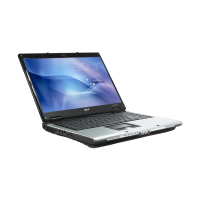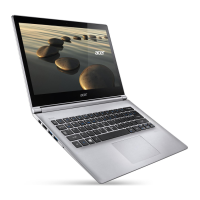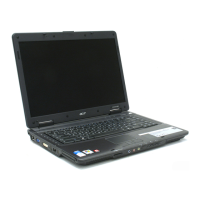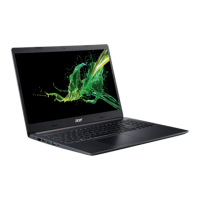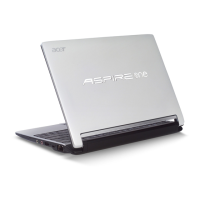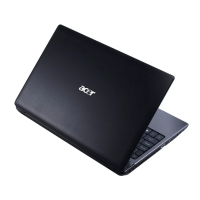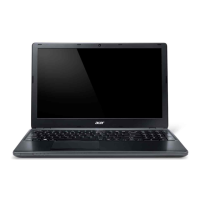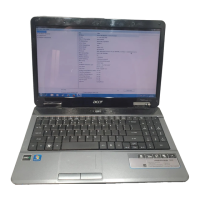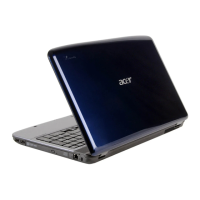
Do you have a question about the Acer Aspire 5630 Series and is the answer not in the manual?
| Processor | Intel Core 2 Duo |
|---|---|
| RAM | Up to 4 GB DDR2 |
| Optical Drive | DVD-Super Multi double-layer drive |
| Wireless | 802.11a/b/g |
| Battery | 6-cell Li-ion battery |
| Networking | Gigabit Ethernet |
| Display | 15.4" WXGA TFT LCD |
| Graphics | Intel GMA 950 |
| Storage | 80GB HDD |
| Operating System | Windows XP Home |
| Weight | 2.8 kg |
| Chipset | Intel 945GM Express |
| Ports | VGA, S-Video, RJ-45, RJ-11, Headphone/speaker/line-out jack |
Read and follow safety instructions for safe operation of the product.
Instructions on how to properly turn off the product for cleaning.
Important warnings regarding water, placement, ventilation, objects, and liquids.
Guidelines for safe and proper use of electrical power.
Advice on adjusting workstation setup for optimal user comfort.
Suggestions for reducing eyestrain during prolonged computer use.
General advice on computer care and usage.
Instructions for powering the computer on and off.
Utility for file encryption and data protection.
Security utility to lock removable, optical, and floppy drives.
System optimization tool to boost notebook performance.
Utility for system backup and data recovery.
Tool for inspecting hardware and monitoring system health.
Utility for connecting to wired and wireless networks.
Manages battery power through various usage profiles.
Connects to projectors and adjusts display settings.
Releases unused memory and checks usage.
Removes unneeded items and files from the disk.
Improves system usability and performance.
Settings for power management when connected to AC power.
Power profiles for different usage scenarios on battery power.
Steps to create custom power management profiles.
Displays estimates of remaining battery life based on current usage.
Identifies components visible on the front of the notebook.
Identifies components visible on the closed front of the notebook.
Identifies components on the left side of the notebook.
Identifies components on the right side of the notebook.
Identifies components on the rear of the notebook.
Identifies components on the base of the notebook.
Details about supported operating systems.
Information on processor and chipset for different models.
Specifications for RAM capacity and upgradeability.
Details on the display panel and graphics capabilities.
Information on hard disk drive and optical drive options.
Physical dimensions and weight of the notebook.
Details about power management, battery, and AC adapter.
Information on keyboard, touchpad, and media keys.
Specifications for the audio system and speakers.
Options and I/O for TV tuner functionality.
Functions of dedicated media control keys.
List of pre-installed software utilities.
Details on video conferencing, camera, WWAN, WLAN, and modem.
Optional accessories and memory modules.
List of various input/output ports on the notebook.
Operating and non-operating temperature and humidity limits.
Compliance with standards like Wi-Fi and ACPI.
Information on the product's warranty.
Explains the meaning of HDD, Caps Lock, Num Lock, Bluetooth, etc. indicators.
How to use the touchpad and its buttons.
Explains execute, select, drag, context menu, and scroll functions of the touchpad.
Explanation of Caps Lock, Num Lock, and Scroll Lock keys.
How to use number and cursor keys on the embedded numeric keypad.
Details on hotkeys for display, power, volume, and settings adjustments.
How to adjust the speaker volume using buttons or hotkeys.
Identifies the components of the Acer OrbiCam.
Instructions on how to rotate the webcam for optimal positioning.
How to change the capture resolution for the webcam.
Options for changing capture window size and preview settings.
Basic settings for video, audio, and zoom/face tracking.
Adjusting brightness, contrast, hue, saturation, and sharpness.
How to use single or multiple user face tracking.
Selecting and applying video effects like avatars.
Utility for managing multiple displays.
Steps to configure and use Acer GridVista for multi-display setups.
Troubleshooting steps for power-on issues.
Solutions for a blank screen issue.
How to resolve full-screen display issues.
Troubleshooting steps for audio problems.
Method to eject disks without powering on the system.
Troubleshooting steps for keyboard input issues.
Troubleshooting steps for the infrared port.
Troubleshooting steps for printer connectivity issues.
How to configure location settings for the internal modem.
Steps to restore the computer using its internal recovery function.
Information about the International Travelers Warranty.
Information to prepare before contacting Acer for support.
How to listen to music files and rip CDs.
How to watch live and recorded TV programs.
How to create an instant replay of live TV broadcasts.
Detailed list and description of each remote control button.
Options for screen ratio and movie display types.
Options for speaker environment and output mode.
Controls for navigating within Acer Arcade.
Standard playback controls for video, music, and slideshows.
Using the onscreen keyboard for data entry.
How to change video and language settings for DVDs.
Tools for rotating, red-eye removal, and auto-fixing images.
Options for slide duration and transition effects.
Steps to play video files and control playback.
How to capture video clips from external devices.
How to capture the onscreen image at any time.
Capabilities for editing video clips, photos, and footage.
How to create an instant replay of live TV broadcasts.
How to view recorded TV files.
How to set up TV recording schedules.
How to view program listing details for channels.
How to search for programs by channel or category.
Options for picture, signal, channel, recording, and guide settings.
Settings for analog/digital input and TV source.
How to scan and list available TV channels.
How to set recording quality and destination.
How to select the source for EPG program listings.
Steps for creating and burning CDs/DVDs with various content.
Information on compatible file types for media modes.
Steps to disconnect accessories before moving the computer.
Tips for moving the computer short distances.
Steps to prepare the computer for moving or travel.
Items to bring for meetings, considering duration and battery charge.
Steps to prepare the computer for transport home.
Items to bring when taking the computer home.
Preparing the computer for travel, including charging the battery.
Items to take when traveling with the computer.
Preparing the computer for international travel.
Items to bring for international travel.
Tips for international travel, including voltage and modem compatibility.
How to use a Kensington-compatible security lock.
Explanation of Supervisor, User, and Boot passwords.
Overview of ports for connecting peripherals.
Information and warnings about the built-in fax/data modem.
How to connect to an Ethernet-based network.
How to perform wireless data transfer using the FIR port.
Information about connecting USB peripherals.
How to connect IEEE 1394-compatible devices.
Information about PC Cards and their uses.
Information about ExpressCards and their installation/ejection.
Step-by-step guide for installing memory modules.
How to connect TV antenna cables for different systems.
How to connect the digital antenna.
Steps to physically set up the antenna for reception.
How to connect the AV-in cable for video input.
How to set the boot sequence in the BIOS.
How to enable the disk-to-disk recovery feature in BIOS.
How to set a password on boot in BIOS.
How to play DVD movies and manage region codes.
Lists Create backup, Restore from backup, Image CD, Reinstall software, and Change password.
Steps to create backup images to HDD, CD, or DVD.
Steps to restore backups from hard disk, CD, or DVD.
How to create bootable disks with the factory OS.
How to reinstall software using internal storage.
Steps to change the password for Acer eRecovery Management.
Utilizing onscreen error messages for problem solving.
Table of error messages and their corrective actions.
Product meets ENERGY STAR guidelines for energy efficiency.
FCC compliance statement regarding radio frequency interference.
Requirement for using shielded cables for connections.
Requirement for using certified peripherals.
Warning about unauthorized modifications voiding user authority.
FCC operational conditions for device compliance.
Compliance statement for Canadian users.
Declaration of compliance with EU directives.
Statement on Russian regulatory certification.
FCC Part 68 compliance for US modem connections.
Approval for single terminal connection to PSTN in EU countries.
List of EU countries where the device is approved.
Safety reasons for connecting Australian headsets.
Telecom requirements and limitations for New Zealand equipment.
Product compliance with radio frequency and safety standards.
Compliance with essential EU directives.
EU countries where the device is approved.
RF exposure limits and safety instructions for wireless devices.
Canadian regulations for low-power radio devices.
